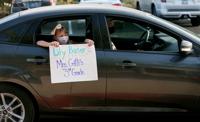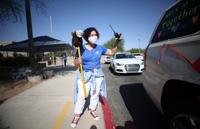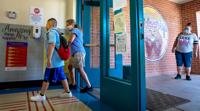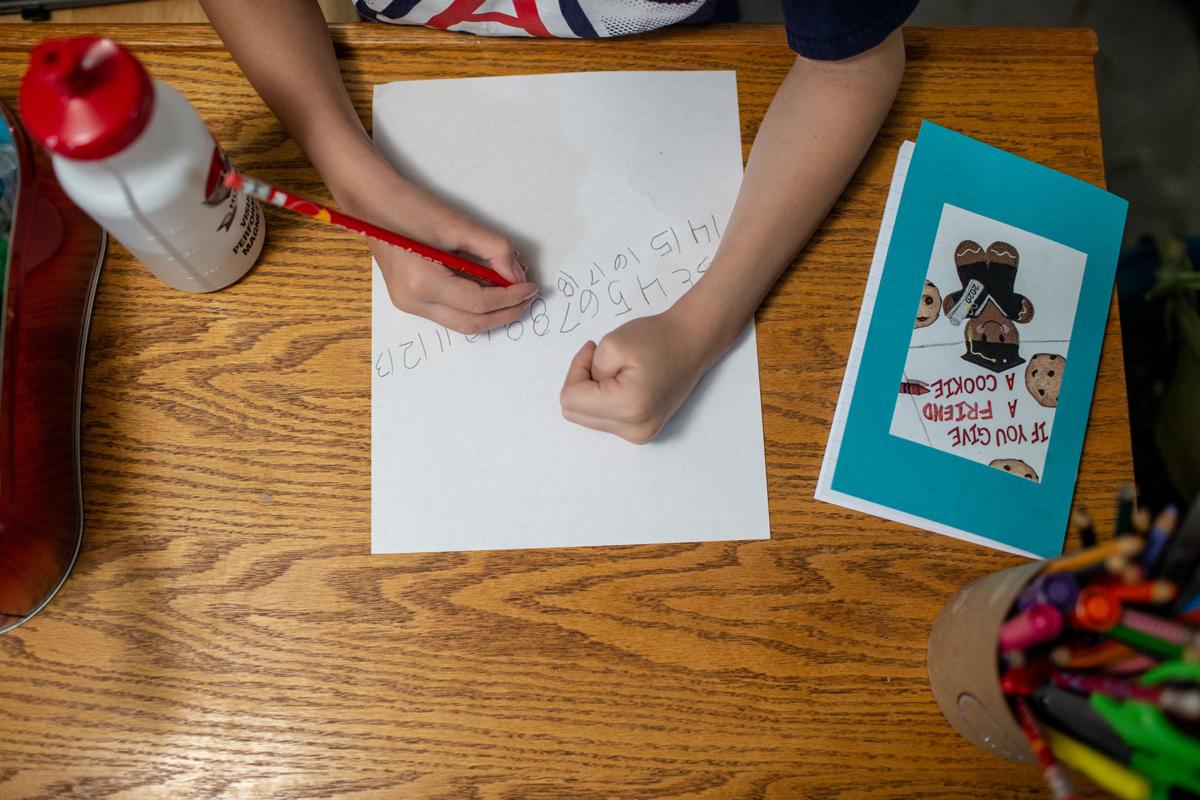Thousands of УлшжжБВЅ students are failing classes while dealing with remote learning and the many challenges of the COVID-19 pandemic.
In УлшжжБВЅ Unified, with more than 42,000 children, there is an тalarming rate of Fтsт especially in middle and high schools, said TUSD Superintendent Gabriel Trujillo.
As the first semester of the 2020-21 school year comes to an end, the number of Fтs is up by nearly 50% over last year in TUSD secondary grades, from about 6,400 failing grades last year to nearly 9,600 now.
In the middle school grades, the number of Fтs has increased by 67% over last year, and in high school there was a 38% increase, with 4,232 Fтs in middle school compared to 2,538 last year, and 5,355 Fтs in high school compared to 3,886 last year.
In Sunnyside, УлшжжБВЅтs second-largest district with more than 14,000 students, there was a 47% failure rate in high school classes at the end of the first quarter, as compared to 29% last year and 23% the year before that.
People are also reading…
That is the percentage of Fтs given out, not the percentage of students failing. In terms of individual students, 61% of students at Desert View High are failing at least one class and 63% at Sunnyside High.
In both high schools, about half of students are failing at least two classes, and 38% of students are failing either or both English and math т classes required to graduate.
The failure rate in Sunnyside middle schools has also increased substantially with 28% of first-quarter grades being Fтs, compared to 9% the previous two years.
тThis is not a Sunnyside-only issue,т Superintendent Steve Holmes said during a Governing Board meeting on Dec. 8. тThis has been an issue that has been plaguing the nation around the amount of Fтs and students failing. Most of the districts across Pima County are seeing at least double what they normally have seen in the average. Weтre no different.т
Flowing Wells schools saw about double the amount of Fтs in the secondary grades at the October progress report. Vail students also had about double the number of Fтs at 20% of grades across all grade levels. The number of middle and high school students who have one or more failing grade in Tanque Verde School District has more than doubled since last year as well. In the Sahuarita School District, the number of middle and high school students with a failing grade had climbed from 429 last year to 780, although those grades arenтt finalized and could change.
In an informal survey by the Star of teachers at district schools in УлшжжБВЅ, many teachers working remote and hybrid models said kids were failing because they are not attending or not turning in work.
Of the 74 educators who weighed in on whether more kids are failing this year, about 78% said yes, among all УлшжжБВЅтs major school districts, regardless of whether the district is fully remote or has been doing hybrid in-person instruction.
Catalina Foothills and Marana didnтt say whether more students were failing this year, but survey respondents from those districts said they had many more students failing.
In Amphitheater, more students are struggling, and the district has directed teachers to change all zeros on assignments to 50%, a tactic being discussed in other districts and which teachers in other districts are already employing on their own.
тGRADING WITH GRACEт
One Amphitheater High School teacher who responded to the Starтs anonymous survey said the only reason she didnтt have more students failing than normal is because of тgrading with grace.т
тI think we are doing a good job grading, but sometimes it seems as if grades donтt mean anything any more,т she wrote. тWe are trying so hard to be тfair under the circumstancesт but it is a huge mess. Students who are out legitimately being quarantined, students whose parents are quarantining them from all in-person attendance, and those missing way more than is typical. Itтs a mess that no one can answer, how we are supposed to handle the grades.т
One Amphi middle school teacher said if the grades were to accurately reflect student work and achievement, she would have 26 students failing, which is more than one-quarter of her caseload.
Another Amphi high school teacher said she fears this is a тlost year.т
тIтm incredibly distressed,т she wrote. тKids are unmotivated, parents donтt know what to do with unmotivated kids/how to handle their ennui; teachers are exhausted from pushing the same boulder uphill for months.т
There is talk in many УлшжжБВЅ school districts about changing the grading system to either make it more lenient or find other ways to measure studentsт understanding of core subjects while avoiding an F for poor attendance or missing work.
A handful of the teachers surveyed who said they donтt have more students failing said that is only because of lenient grading practices.
Parents, students, teachers and other concerned citizens protest in support of in-person teaching outside the Pima County Administratorтs Offi…
TUSD is working with the teachers union to find a solution that will тstrike a balance between student accountability and teacher responsibility,т Superintendent Trujillo said, as well as making sure that there are interventions and communication with parents and more opportunities to raise grades.
Grading is the purview of the teacher, and teachers are considering the tough circumstances children are in, says УлшжжБВЅ Education Association President Margaret Chaney.
For students in eighth grade and high school, in cases where their grades could adversely impact scholarship opportunities and course eligibility, TUSD teachers may allow students to seek a тpassт grade as long as they earned a B, C or D in the class. The student would then have the opportunity to retake the class within a specified time frame to have the тPт grade replaced with a higher grade.
тI know that as a student, you might have access to everything but you may not be able to focus and concentrate like you normally would in a school setting,т she said. тYouтve got three other kids in the same room with you, and theyтre all doing whatever it is that theyтre doing. Or maybe a parent is sick, or maybe youтre about to get evicted. Thereтs so many possibilities right now. It is not a very bright world to be a child in.т
WHATтS BEHIND the FAILING GRADES?
Teachers who took the Starтs survey said that studentsт home environments are often not conducive to learning; there is often little or no parental support at home; the hybrid model lacks consistency; students lack self-management strategies; many students are watching siblings or taking care of sick family members; and many students seem depressed or unmotivated т all factors that contribute to more failing grades.
While TUSD worked to get all students access to online learning tools, they were still waiting on devices during the first three weeks of the school year, meaning students didnтt start the year off with the tools they needed. There was also a lack of clarity on reading expectations and workloads, Trujillo said.
тWe canтt be making sweeping assumptions that kids are simply refusing to do work, nor can we make a sweeping assumption that sometimes our kids arenтt a little bit lazy and donтt want to log on,т Trujillo said during the Dec. 8 school board meeting. тWe canтt make assumptions that students had everything that they needed with regard to technology, access to technology or Wi-Fi hot spots at the beginning of the school year.т
Some of the reasons Sunnyside officials identified for students struggling include: the switch to hybrid requiring students to change schedules and many older students have competing responsibilities.
At the high school level, some Sunnyside students went out and found low-wage jobs while their parents got laid off. Many high school students and even middle school students are caring for younger siblings and relatives. And theyтve had internet connectivity problems т even if the district was able to provide an internet connection and a device.
Many students are also tasked with doing classes on their own while their parents are at work. For example, in Sunnysideтs Apollo Middle School, more than 50% of students donтt have an adult with them during the day, and more than 50% are watching younger siblings, says Principal Thad Dugan.
Some students are in households that have lost all their income because of the pandemic, and some have had to move because of financial hardship, Dugan said during Sunnysideтs Dec. 8 Governing Board meeting.
тItтs almost a case-by-case basis, trying to get a hold of people, trying to get kids in the study hall,т he said.
STEPPING UP WITH INTERVENTIONS
Sunnyside is asking kids who are struggling to come in twice a week for in-person study hall, with the district providing transportation to the students who need it.
The district is also doing consistent outreach on attendance reports through calls to families, counselor outreach and making targeted home visits to students who are failing required classes or multiple classes.
Sunnyside also has a number of mental-health interventions and services that are being offered to students.
TUSD is also working on intervention techniques including a targeted academic support plan that will include identifying struggling students, small-group supplemental instruction, progress monitoring and written notification to parents.
After putting interventions into place, Sunnyside saw the failure rate drop from 47% to 35.6% in about a month among the districtтs 4,300 high school students.
The district also plans to put some COVID-19 relief funds toward creating a more robust summer school. And grading right now needs to combine accountability and flexibility, Holmes said.
Photos: Back-to-school in УлшжжБВЅ during the pandemic
"Mustang Stampede"

Maddy Jacobs, 7, middle, reaches for her remote learning tool kit from her teacher, Kris Green, as her friend, Carly Kupinski, 6, watches during a "Mustang Stampede" at Manzanita Elementary School for the first day of school on August 17, 2020.Т
First Day of School, John B. Wright Elementary

Augusta Iranzi, center, attends his teachers online class while monitors Jasmine Phillip, left, and Nadifo Yusuf, watch students inside a classroom at John B. Wright Elementary School, 4311 E. Linden St., in УлшжжБВЅ, Ariz. on August 17, 2020. About 10 students came to school for online instruction under the guidance of classroom monitors.
"Mustang Stampede"

Lily Baser, 8, identifies herself for easy remote learning tool kit pickup during a "Mustang Stampede" at Manzanita Elementary School for the first day of school on August 17, 2020.Т
"Mustang Stampede"

Krista Westmoreland, left, a third grade teacher, shows the remote learning tool kit of a student to Anna Ames, music teacher, during the "Mustang Stampede" at Manzanita Elementary School for the first day of school on August 17, 2020.Т
"Mustang Stampede"

Maya Brown, 9, rides in style for her remote learning tool kit pickup during a "Mustang Stampede" at Manzanita Elementary School for the first day of school on August 17, 2020.Т
"Mustang Stampede"

Multiage teachers Kris Green left, and April Pollow greet and cheer on their students during a "Mustang Stampede" at Manzanita Elementary School for the first day of school on August 17, 2020.Т
"Mustang Stampede"

Maddy Jacobs, 7, left, waves to her teacher as she stands in the sunroof with her friend, Carly Kupinski, 6, during a "Mustang Stampede" to pickup their remote learning tool kit at Manzanita Elementary School for the first day of school on August 17, 2020.Т
"Mustang Stampede"

For the first day of school teachers at Manzanita Elementary School greeted their students during a "Mustang Stampede" and handed out remote learning tool kits on August 17, 2020.Т
"Mustang Stampede"

Kim Boling, principal at Manzanita Elementary School, greets her students and parents with a mustang during the "Mustang Stampede" for the first day of school on August 17, 2020.Т
First Day of School, John B. Wright Elementary

Yarani Martinez gives a monitor a thumbs up to inform the monitor that his online class is working after classes began at John B. Wright Elementary School, 4311 E. Linden St., in УлшжжБВЅ, Ariz. on August 17, 2020. About 10 students came to school for online instruction under the guidance of classroom monitors.
First Day of School, John B. Wright Elementary

Alice Flores, right, watches as her grandson Jesus Silva is escorted to the cafeteria before classes began at John B. Wright Elementary School, 4311 E. Linden St., in УлшжжБВЅ, Ariz. on August 17, 2020. About 10 students came to school for online instruction under the guidance of classroom monitors.
First Day of School, John B. Wright Elementary

Augusta Iranzi follows the directions on the floor while being escorted to a classroom at John B. Wright Elementary School, 4311 E. Linden St., in УлшжжБВЅ, Ariz. on August 17, 2020. About 10 students came to school for online instruction under the guidance of classroom monitors.






















